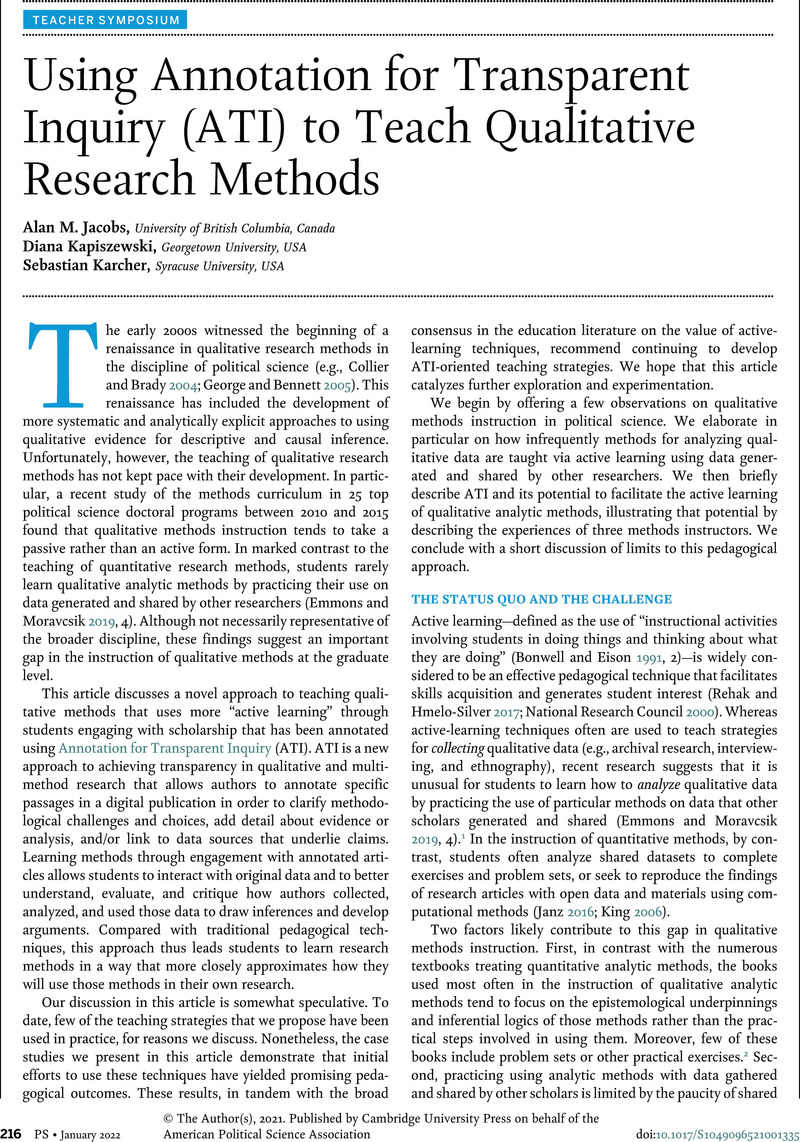No CrossRef data available.
Article contents
Using Annotation for Transparent Inquiry (ATI) to Teach Qualitative Research Methods
Published online by Cambridge University Press: 21 December 2021
Abstract
An abstract is not available for this content so a preview has been provided. Please use the Get access link above for information on how to access this content.

Information
- Type
- Teaching Political Methodology
- Information
- Copyright
- © The Author(s), 2021. Published by Cambridge University Press on behalf of the American Political Science Association
References
REFERENCES
Bonwell, Charles, and Eison, James. 1991. Active Learning: Creating Excitement in the Classroom. ASHE-ERIC Higher Education Reports. Washington, DC: School of Education, George Washington University.Google Scholar
Collier, David. 2011. “Understanding Process Tracing.” PS: Political Science & Politics 44 (4): 823–30. https://doi.org/10.1017/S1049096511001429.Google Scholar
Collier, David, and Brady, Henry (eds.). 2004. Rethinking Social Inquiry: Diverse Tools, Shared Standards. Lanham, MD: Rowman & Littlefield.Google Scholar
Emmons, Cassandra V., and Moravcsik, Andrew M.. 2019. “Graduate Qualitative Methods Training in Political Science: A Disciplinary Crisis.” PS: Political Science & Politics 53 (2): 1–7. https://doi.org/10.1017/S1049096519001719.Google Scholar
George, Alexander L., and Bennett, Andrew. 2005. Case Studies and Theory Development in the Social Sciences. Cambridge, MA: MIT Press.Google Scholar
Janz, Nicole. 2016. “Bringing the Gold Standard into the Classroom: Replication in University Teaching.” International Studies Perspectives 17:392–407. https://doi.org/10.1111/insp.12104.Google Scholar
Kapiszewski, Diana, and Karcher, Sebastian. 2020. “Transparency in Practice in Qualitative Research.” PS: Political Science & Politics. https://doi.org/10.1017/S1049096520000955.CrossRefGoogle Scholar
Kapiszewski, Diana, and Karcher, Sebastian. 2021. “Empowering Transparency: Annotation for Transparent Inquiry (ATI).” PS: Political Science & Politics 54(3): 473–78. https://doi.org/10.1017/S1049096521000287.Google Scholar
Karcher, Sebastian. 2016. “Teaching with Qualitative Data: An Example.” QDR Blog, September 28. https://qdr.syr.edu/qdr-blog/teaching-qualitative-data-example.Google Scholar
Karcher, Sebastian, and Weber, Nicholas. 2019. “Annotation for Transparent Inquiry: Transparent Data and Analysis for Qualitative Research.” IASSIST Quarterly 43 (2): 1–9. https://doi.org/10.29173/iq959.Google Scholar
King, Gary. 2006. “Publication, Publication.” PS: Political Science & Politics 39 (1): 119–25.Google Scholar
Masullo, Juan. 2020. “Civilian Contention in Civil War: How Ideational Factors Shape Community Responses to Armed Groups.” Comparative Political Studies 54 (10): 1849–84. https://doi.org/10.1177/0010414020912285.CrossRefGoogle Scholar
Moravcsik, Andrew. 2010. “Active Citation: A Precondition for Replicable Qualitative Research.” PS: Political Science & Politics 43 (1): 29–35. https://doi.org/10.1017/S1049096510990781.Google Scholar
National Research Council. 2000. “How People Learn: Brain, Mind, Experience, and School: Expanded Edition.” Washington, DC: National Academies Press. https://doi.org/10.17226/9853.Google Scholar
O’Mahoney, Joseph. 2017. “Making the Real: Rhetorical Adduction and the Bangladesh Liberation War.” International Organization 71 (2): 317–48. https://doi.org/10.1017/S0020818317000054.CrossRefGoogle Scholar
Rehak, Andi M., and Hmelo-Silver, Cindy E.. 2017. “Active Learning.” In The SAGE Encyclopedia of Out-of-School Learning, ed. Peppler, Kylie, 5–9. New York: SAGE Publications.Google Scholar
Saunders, Elizabeth. 2011. Leaders at War: How Presidents Shape Military Interventions. Ithaca, NY: Cornell University Press.CrossRefGoogle Scholar

